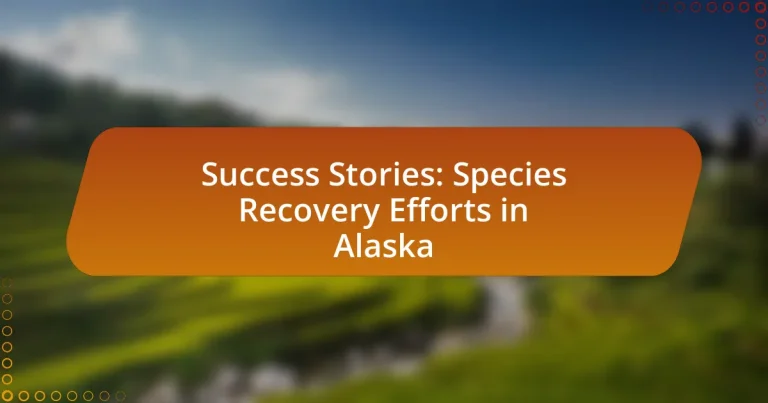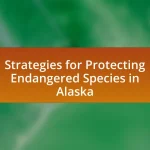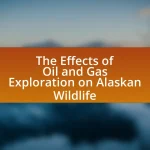The article focuses on the successful species recovery efforts in Alaska, highlighting key initiatives such as the restoration of the Steller sea lion, the recovery of the Aleutian goose, and the conservation of the polar bear. It outlines the evolution of these efforts from initial protective measures to comprehensive, science-based management strategies that involve local communities and adaptive practices. The article also discusses notable success stories, the impact of legislation like the Endangered Species Act, and the importance of habitat restoration and community involvement in enhancing biodiversity and ecosystem health in Alaska. Additionally, it addresses the challenges faced in recovery efforts and the lessons learned that can be applied to other regions.
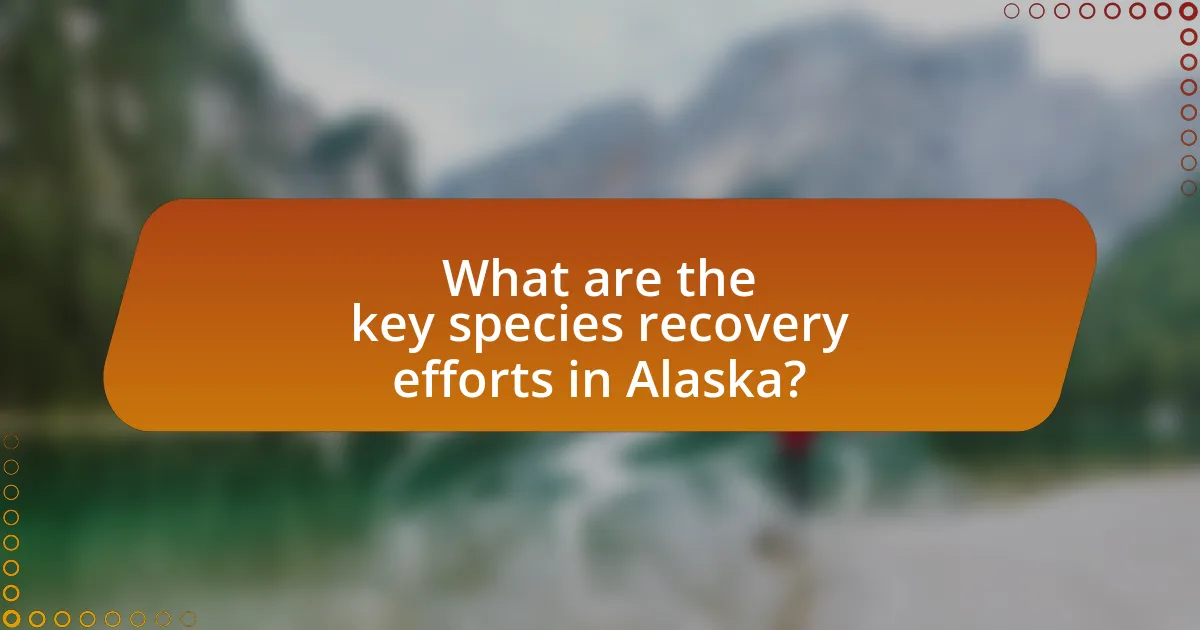
What are the key species recovery efforts in Alaska?
Key species recovery efforts in Alaska include the restoration of the Steller sea lion, the recovery of the Aleutian goose, and the conservation of the polar bear. The Steller sea lion population has increased due to protective measures implemented under the Marine Mammal Protection Act, which has led to a population rebound from approximately 18,000 in the 1970s to over 70,000 today. The Aleutian goose was removed from the endangered species list in 2001 after successful habitat restoration and management efforts, resulting in a population growth from fewer than 1,000 individuals in the 1970s to over 100,000. Additionally, polar bear conservation efforts focus on habitat protection and climate change mitigation, as these bears are classified as a threatened species under the Endangered Species Act due to diminishing sea ice.
How have these efforts evolved over time?
Species recovery efforts in Alaska have evolved significantly from initial conservation measures to comprehensive, science-based management strategies. In the early stages, efforts primarily focused on protecting endangered species through habitat preservation and legal protections, such as the Endangered Species Act of 1973, which provided a framework for recovery plans. Over time, these efforts have expanded to include collaborative approaches involving local communities, indigenous knowledge, and adaptive management practices that respond to ecological changes. For instance, the recovery of the Steller’s eider, a threatened sea duck, has involved habitat restoration and monitoring programs that adapt based on population trends and environmental conditions. This evolution reflects a shift towards more integrated and holistic conservation strategies that consider both ecological and socio-economic factors, leading to more effective outcomes in species recovery.
What historical events prompted species recovery initiatives?
The Endangered Species Act of 1973 is a key historical event that prompted species recovery initiatives in the United States, including Alaska. This legislation aimed to protect and recover imperiled species and their habitats, leading to focused conservation efforts for various species at risk of extinction. Additionally, the decline of species such as the California condor and the gray wolf highlighted the urgent need for recovery initiatives, prompting federal and state agencies to implement recovery plans and habitat restoration projects. These events underscored the importance of legislative action and public awareness in driving species recovery efforts.
How have conservation strategies changed in Alaska?
Conservation strategies in Alaska have evolved to incorporate more collaborative and science-based approaches. Historically, conservation efforts focused primarily on species protection through legislation, such as the Endangered Species Act, but recent strategies emphasize habitat restoration, community involvement, and adaptive management practices. For instance, the Alaska Wildlife Conservation Center has implemented programs that engage local communities in wildlife monitoring and habitat restoration, reflecting a shift towards inclusive conservation that recognizes the importance of local knowledge and stakeholder participation. This change is supported by data showing improved outcomes for species like the Steller’s sea lion, which has benefited from integrated management strategies that address both ecological and socio-economic factors.
What are some notable success stories in species recovery?
Notable success stories in species recovery include the recovery of the bald eagle, which was removed from the U.S. Endangered Species List in 2007 due to a significant population increase from just 417 breeding pairs in the 1960s to over 71,000 pairs today. Another example is the gray wolf, which has been successfully reintroduced in Yellowstone National Park, leading to a thriving population that has positively impacted the ecosystem. Additionally, the California condor, once on the brink of extinction with only 27 individuals in 1987, has seen its numbers rise to over 500 due to intensive conservation efforts. These examples demonstrate effective recovery strategies and the resilience of species when given proper protection and management.
Which species have shown significant recovery in Alaska?
The species that have shown significant recovery in Alaska include the Steller sea lion, the bald eagle, and the gray whale. The Steller sea lion population has rebounded from approximately 18,000 individuals in the 1970s to over 70,000 by 2018, largely due to conservation efforts and legal protections. The bald eagle, once endangered, has seen its numbers increase from fewer than 500 nesting pairs in the 1960s to over 70,000 pairs today, thanks to the banning of DDT and habitat protection. The gray whale population has also recovered from near extinction in the 1970s, with current estimates exceeding 20,000 individuals, attributed to international protections and conservation measures.
What methods were used to achieve these recoveries?
The methods used to achieve species recoveries in Alaska include habitat restoration, population monitoring, and targeted conservation programs. Habitat restoration involves rehabilitating ecosystems to support native species, while population monitoring tracks the health and numbers of species to inform management decisions. Targeted conservation programs, such as breeding and release initiatives, have been implemented for specific species, ensuring their survival and growth in the wild. These methods have been validated through successful case studies, such as the recovery of the Steller’s eider and the Aleutian cackling goose, demonstrating their effectiveness in enhancing biodiversity in Alaska.
Why are species recovery efforts important for Alaska’s ecosystem?
Species recovery efforts are crucial for Alaska’s ecosystem because they help restore biodiversity and maintain ecological balance. The recovery of species such as the Steller sea lion and the Aleutian goose has demonstrated that targeted conservation actions can reverse population declines and enhance ecosystem health. For instance, the population of the Aleutian goose increased from fewer than 1,000 individuals in the 1970s to over 100,000 by 2018 due to dedicated recovery programs. This resurgence not only supports the species itself but also benefits other wildlife and plant communities, illustrating the interconnectedness of Alaska’s ecosystems.
How do recovered species impact biodiversity in Alaska?
Recovered species positively impact biodiversity in Alaska by restoring ecological balance and enhancing ecosystem resilience. For instance, the recovery of the sea otter population has led to a resurgence of kelp forests, which provide habitat for numerous marine species. This trophic cascade illustrates how the presence of a recovered predator can influence the entire marine ecosystem, promoting greater species diversity. Additionally, the successful reintroduction of the gray wolf in certain areas has helped regulate herbivore populations, further supporting plant diversity and overall ecosystem health. These examples demonstrate that species recovery efforts contribute significantly to maintaining and enhancing biodiversity in Alaska.
What role do recovered species play in local communities?
Recovered species play a crucial role in local communities by enhancing biodiversity, supporting ecosystem stability, and contributing to cultural and economic values. For instance, the recovery of the sea otter in Alaska has led to healthier kelp forest ecosystems, which in turn supports fisheries that local communities rely on for their livelihoods. Additionally, the presence of recovered species can foster ecotourism, providing economic benefits through wildlife viewing and education. Studies have shown that areas with diverse species populations often experience increased resilience to environmental changes, further underscoring the importance of species recovery in maintaining community well-being.
How do community involvement and education contribute to recovery efforts?
Community involvement and education significantly enhance recovery efforts by fostering local engagement and increasing awareness about conservation. When communities actively participate in recovery initiatives, they contribute valuable local knowledge and resources, which can lead to more effective strategies tailored to specific species and ecosystems. For instance, in Alaska, local communities have collaborated with scientists to monitor wildlife populations and restore habitats, resulting in successful recovery of species such as the Steller’s eider. Educational programs raise awareness about the importance of biodiversity and conservation, empowering individuals to take action and support recovery efforts. Research indicates that communities with strong educational outreach are more likely to engage in sustainable practices, which directly benefits recovery initiatives.
What challenges do species recovery efforts face in Alaska?
Species recovery efforts in Alaska face significant challenges, including climate change, habitat loss, and limited funding. Climate change alters ecosystems, affecting species’ migration patterns and food availability, which complicates recovery strategies. Habitat loss due to industrial development, such as oil drilling and logging, further diminishes the natural environments essential for species survival. Additionally, funding constraints hinder the implementation of comprehensive recovery plans, limiting research and conservation initiatives. These factors collectively impede the effectiveness of recovery efforts for vulnerable species in the region.
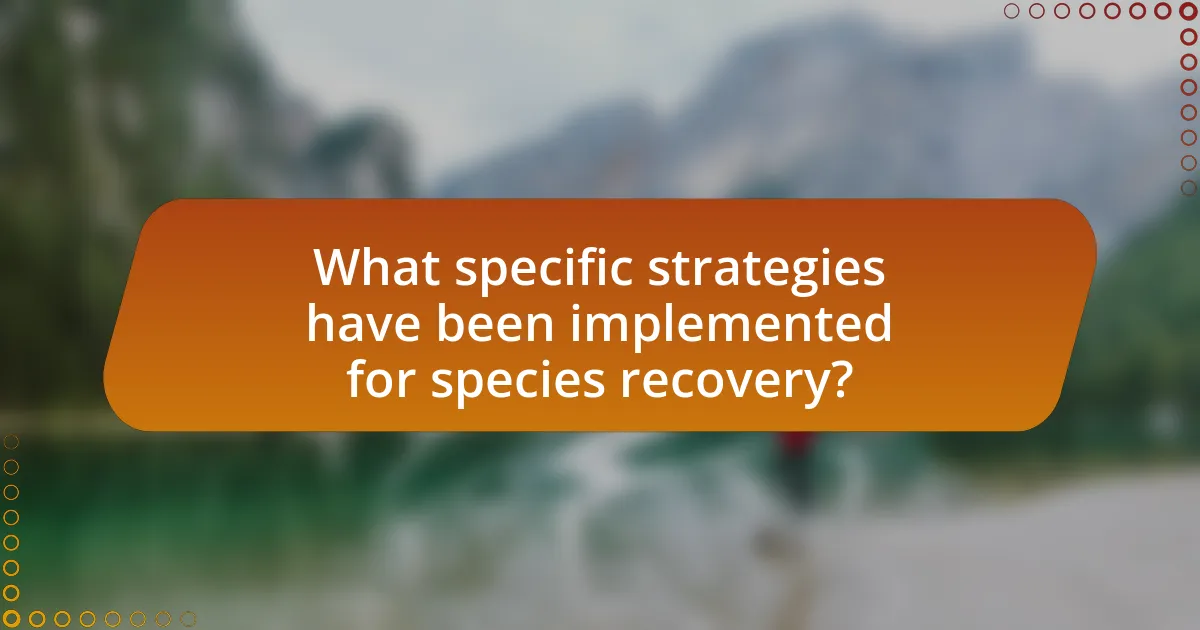
What specific strategies have been implemented for species recovery?
Specific strategies implemented for species recovery in Alaska include habitat restoration, population monitoring, and legal protections. Habitat restoration efforts focus on rehabilitating ecosystems to support native species, such as the restoration of wetlands for migratory birds. Population monitoring involves tracking species numbers and health, which is crucial for assessing recovery progress; for example, the monitoring of the Steller sea lion population has informed management decisions. Legal protections, such as the Endangered Species Act, provide frameworks for conservation efforts, ensuring that threatened species receive necessary support and resources. These strategies have led to notable recoveries, such as the successful rebound of the Aleutian Canada goose population, which increased from fewer than 1,000 individuals in the 1970s to over 100,000 today.
How do habitat restoration projects support recovery efforts?
Habitat restoration projects support recovery efforts by re-establishing ecosystems that provide essential resources for endangered species. These projects often involve removing invasive species, restoring native vegetation, and improving water quality, which collectively enhance the habitat’s ability to sustain wildlife. For instance, in Alaska, the restoration of coastal wetlands has been shown to benefit migratory bird populations by providing critical feeding and nesting areas. Studies indicate that such efforts can lead to increased biodiversity and improved population dynamics for species that rely on these habitats, demonstrating the effectiveness of restoration in facilitating recovery.
What are the key components of successful habitat restoration?
The key components of successful habitat restoration include ecological assessment, stakeholder engagement, appropriate species selection, and ongoing monitoring. Ecological assessment involves evaluating the current state of the habitat to identify degradation levels and restoration needs. Stakeholder engagement ensures that local communities, governments, and organizations collaborate effectively, which is crucial for resource allocation and support. Appropriate species selection focuses on choosing native species that can thrive in the restored environment, promoting biodiversity and ecosystem resilience. Ongoing monitoring is essential to track progress, adapt management strategies, and ensure the long-term success of restoration efforts. These components are supported by numerous case studies, such as the restoration of the Kenai River watershed, which demonstrated that integrating these elements leads to improved ecological outcomes and species recovery.
How is habitat restoration monitored and evaluated?
Habitat restoration is monitored and evaluated through a combination of ecological assessments, biodiversity surveys, and the use of specific indicators such as species population trends and habitat quality metrics. These methods allow researchers and conservationists to track changes over time, ensuring that restoration efforts are effective in improving ecosystem health. For instance, in Alaska, the monitoring of species like the Steller’s eider involves regular population counts and habitat assessments to determine the success of restoration initiatives. Studies have shown that consistent monitoring leads to adaptive management strategies, enhancing the overall effectiveness of habitat restoration projects.
What role does legislation play in species recovery in Alaska?
Legislation plays a crucial role in species recovery in Alaska by establishing legal frameworks that protect endangered species and their habitats. The Endangered Species Act (ESA) is a key piece of legislation that has facilitated the recovery of various species in Alaska, such as the Steller sea lion and the polar bear, by providing mechanisms for habitat conservation, recovery planning, and federal funding for conservation efforts. Additionally, state laws complement federal regulations by addressing local conservation needs and promoting collaboration among stakeholders, which enhances the effectiveness of recovery initiatives.
Which laws and policies are crucial for conservation efforts?
The Endangered Species Act (ESA) is crucial for conservation efforts, as it provides a framework for the protection of threatened and endangered species and their habitats. Enacted in 1973, the ESA has led to the recovery of numerous species, including the bald eagle and the gray wolf, by prohibiting actions that harm these species and promoting habitat conservation. Additionally, the Marine Mammal Protection Act (MMPA) safeguards marine mammals, ensuring their populations are maintained and protected from human activities. These laws are supported by various policies that promote habitat restoration, sustainable land use, and collaboration among federal, state, and local agencies, which are essential for effective conservation strategies in Alaska.
How do these regulations impact recovery initiatives?
Regulations significantly enhance recovery initiatives by providing structured frameworks that protect endangered species and their habitats. These regulations, such as the Endangered Species Act, enforce conservation measures that directly contribute to the recovery of species by limiting habitat destruction and promoting restoration efforts. For instance, the implementation of these regulations has led to the successful recovery of species like the Aleutian Canada goose, which was once on the brink of extinction due to habitat loss and predation. The legal protections afforded by such regulations ensure that recovery initiatives receive necessary funding and resources, facilitating monitoring and management efforts essential for species survival.
What partnerships have been formed to enhance recovery efforts?
Partnerships formed to enhance recovery efforts in Alaska include collaborations between state and federal agencies, non-profit organizations, and local communities. For instance, the Alaska Department of Fish and Game collaborates with the U.S. Fish and Wildlife Service and various conservation groups to implement recovery plans for endangered species such as the Steller’s eider and the Aleutian goose. These partnerships leverage resources, expertise, and local knowledge to effectively address conservation challenges and promote species recovery.
How do collaborations between organizations improve outcomes?
Collaborations between organizations improve outcomes by leveraging diverse expertise and resources to achieve common goals more effectively. For instance, in Alaska, partnerships among governmental agencies, non-profits, and local communities have led to successful species recovery efforts, such as the restoration of the Steller’s eider population. These collaborations enable the sharing of data, funding, and best practices, which enhances the overall impact of conservation initiatives. Research indicates that multi-stakeholder collaborations can increase project success rates by up to 30%, demonstrating the tangible benefits of working together towards shared objectives.
What examples of successful partnerships exist in Alaska?
Successful partnerships in Alaska include the collaboration between the U.S. Fish and Wildlife Service and local Native corporations, which has led to the recovery of the Steller’s eider population. This partnership combines traditional ecological knowledge with scientific research, resulting in effective habitat management strategies. Additionally, the Alaska SeaLife Center’s partnership with various research institutions has facilitated the rehabilitation of injured marine wildlife, demonstrating the impact of collaborative efforts on species recovery. These partnerships exemplify how combining resources and expertise can lead to significant conservation outcomes in Alaska.
What lessons can be learned from Alaska’s species recovery efforts?
Alaska’s species recovery efforts demonstrate the importance of habitat protection, community involvement, and adaptive management. These efforts have shown that preserving natural habitats is crucial for the survival of endangered species, as seen in the recovery of the Steller sea lion, which benefited from the establishment of marine protected areas. Community engagement has proven essential, as local stakeholders often provide valuable insights and support for conservation initiatives, exemplified by the collaboration between state agencies and indigenous groups in managing wildlife. Additionally, adaptive management practices, which involve monitoring and adjusting strategies based on outcomes, have been vital in responding to changing environmental conditions, as evidenced by the successful recovery of the Aleutian goose through ongoing research and management adjustments.
How can these lessons be applied to other regions?
The lessons from species recovery efforts in Alaska can be applied to other regions by implementing targeted conservation strategies that address specific ecological challenges. For instance, the successful reintroduction of species like the gray wolf in Alaska demonstrates the importance of habitat restoration and community involvement in conservation efforts. Research indicates that similar approaches, such as engaging local stakeholders and utilizing adaptive management practices, have led to successful recovery of species in diverse ecosystems, as seen in the Yellowstone National Park case. By tailoring these strategies to the unique environmental and social contexts of other regions, effective species recovery can be achieved globally.
What best practices have emerged from Alaska’s experiences?
Best practices that have emerged from Alaska’s experiences in species recovery efforts include collaborative management, community involvement, and adaptive management strategies. Collaborative management involves partnerships between state and federal agencies, local communities, and stakeholders, which has proven effective in addressing complex ecological challenges. Community involvement ensures that local knowledge and cultural values are integrated into recovery plans, enhancing the effectiveness and acceptance of conservation measures. Adaptive management strategies allow for ongoing assessment and modification of recovery efforts based on new data and changing conditions, ensuring that approaches remain relevant and effective. These practices have been validated through successful recovery of species such as the Steller sea lion and the Aleutian goose, demonstrating their efficacy in real-world applications.
How can future recovery efforts be improved based on past successes?
Future recovery efforts can be improved by adopting strategies that have proven effective in past species recovery initiatives in Alaska, such as the successful reintroduction of the gray wolf to the Kenai Peninsula. This case demonstrated the importance of habitat restoration, community involvement, and ongoing monitoring. For instance, the gray wolf population increased significantly after habitat management practices were implemented, which included protecting prey species and ensuring ecological balance. Additionally, engaging local communities in conservation efforts fostered support and compliance, leading to sustainable outcomes. These elements highlight the necessity of a collaborative approach, scientific research, and adaptive management in enhancing future recovery efforts.
What practical steps can individuals take to support species recovery?
Individuals can support species recovery by participating in local conservation efforts, such as habitat restoration projects and wildlife monitoring programs. Engaging in these activities helps to restore ecosystems and provides critical data for understanding species populations. For instance, volunteering with organizations like the Alaska Wildlife Conservation Center allows individuals to contribute directly to the rehabilitation of native species and their habitats. Additionally, individuals can reduce their ecological footprint by adopting sustainable practices, such as minimizing plastic use and supporting local conservation initiatives, which collectively enhance the resilience of ecosystems. According to the U.S. Fish and Wildlife Service, community involvement in conservation has been shown to significantly improve the success rates of species recovery efforts.
